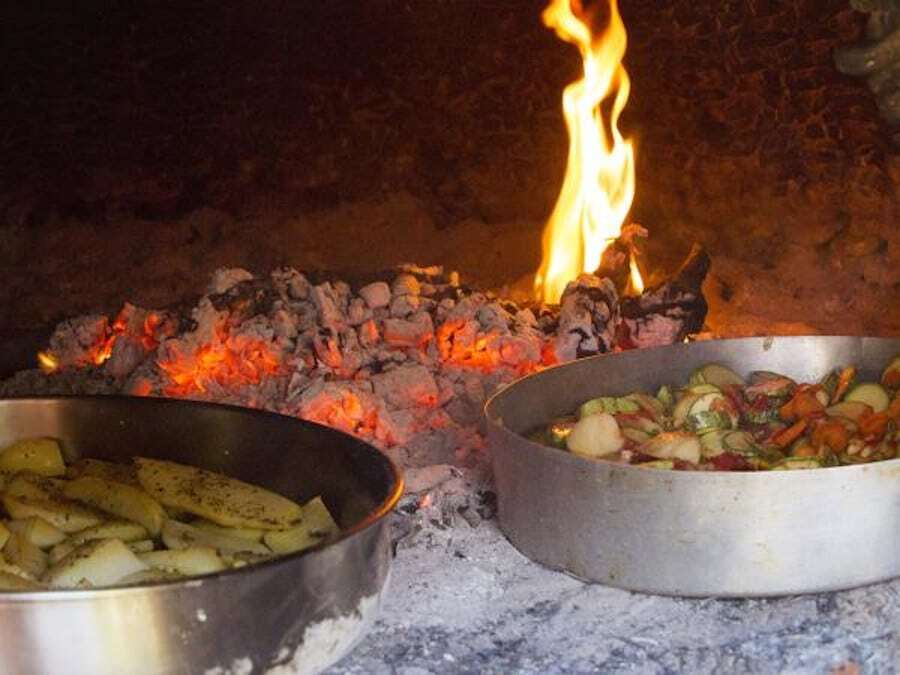The Peloponnese has a long gastronomic history. Many regions and their products were widely famous from antiquity, like Nemea’s vineyards, Messenia’s olive oil, the aromatic plants and herbs of Arcadia, the vegetables of Corinth, and Sparta’s dark broth. Due to the enormous extent and diversity of its soil, the Peloponnese is richly endowed with products and flavours. Also highly developed are livestock farming and fisheries. There is also much cultivation of fruits and vegetables, as well as grains that yield pasta of high quality.
Savouring the Peloponnese: A Culinary Journey Through Greece’s Southern Heartland
To travel through the Peloponnese is to trace the contours of myth itself. This vast peninsula, shaped like a plane leaf and connected to the mainland by the slender thread of the Corinth Canal, is the realm of ancient Sparta, the birthplace of the Olympic Games, and the domain of King Agamemnon. But beyond the marble ruins and epic histories lies a living, breathing culture, one that finds its most profound and joyful expression on the dinner table. The Peloponnese is not just a destination for the history buff; it is a paradise for the gastronome.
Here, the cuisine is a sun-drenched tapestry woven from mountain, sea, and valley. It is robust and unpretentious, echoing the character of its people—proud, resilient, and deeply connected to their land. A culinary journey through the Peloponnese is a voyage into the very soul of Greek philoxenia (hospitality), where every meal is a celebration and every flavour tells a story.
The Holy Trinity: Olive Oil, Wine, and the Mediterranean Larder
The Peloponnese’s culinary identity rests on a sacred trinity: sublime olive oil, vibrant wines, and the bounty of its diverse landscapes.
Liquid Gold: The Sacred Elixir of the Peloponnese
To speak of Peloponnesian cuisine is to begin with olive oil. It is more than an ingredient; it is a cultural constant, an ancient legacy poured from clay pithoi in antiquity to sleek, dark glass bottles today. The relationship between this land and the olive tree is one of symbiosis, stretching back over millennia. Homer himself called it “liquid gold,” and in the Peloponnese, that gold still flows abundantly.
- A Tapestry of Terroir: While the Kalamata olive reigns supreme as a table variety, the oil-producing landscape is wonderfully diverse. The dominant cultivar is the Koroneiki, a small, unassuming olive that yields an oil of astonishing character. But the taste of that oil is a direct reflection of its origin:
- Messenia: The most celebrated region, where gentle slopes descend to the Ionian Sea. Messenian oil is often the benchmark: intensely fruity with notes of green grass, fresh artichoke, and a clean, peppery finish that tingles pleasantly at the back of the throat. It’s elegant and well-balanced.
- Laconia: The oils from the Mani Peninsula and the slopes of Taygetus are more assertive. They are often greener, more herbaceous, with a robust peppery kick and a distinct bitterness that signals high levels of antioxidants. This is an oil for those who like their flavours bold and unapologetic.
- Argolis & the North: The oils here can be lighter and fruitier, with aromatic notes of almond and green tomato, a reflection of the warmer, drier microclimates.
- Elia Prevezous: A unique, early-harvest oil from Arcadia, often characterised by a striking, bold bitterness and intense fruitiness, highly prized by connoisseurs.
- The Harvest Ritual: The annual harvest, from late October to January, is a ritual that defines the Peloponnesian winter. Families and communities gather under the silver-canopied trees. Nets are spread, and the careful work begins—mostly by hand or with small mechanical rakes to avoid bruising the fruit. The urgency is palpable; to produce the highest quality extra virgin oil, the olives must be rushed to the press (ergostasio) within hours of harvesting. The modern cold-press process is a marvel of efficiency, but the scent that fills the air—a vibrant, grassy, intensely green aroma—is timeless. Tasting the oil, warm and cloudy, straight from the centrifuge, is a near-religious experience for any food lover.
- Beyond the Bottle: In the Peloponnese, olive oil is not just for dressing salads. It is the medium for frying, the base for sauces, a preservative for cheeses and feta, and a final flourish on grilled fish, soups, and legumes. A simple plate of hearty bread for papara (bread soaked in broth) or fakes (lentil soup) isn’t complete without a generous glug of the local nectar. It is the unwavering thread that ties every element of the table together.
Vineyards of Myth: Where Dionysus Still Dances
If the olive tree is the soul of the land, then the grapevine is its beating heart. The Peloponnese is Greece’s largest wine-producing region, a place where viticulture is woven into the very fabric of myth. This is the land where King Oeneus (“wineman”) was said to have ruled, and where the heroes of the Trojan War sought solace in wine. Today, that ancient tradition is experiencing a spectacular renaissance, driven by a new generation of winemakers who are blending indigenous grapes with modern techniques.
- The Red Giant of Nemea: Agiorgitiko: In the rolling hills of Nemea, the air is thick with the legend of Hercules and the Nemean Lion. But the true power here is the Agiorgitiko grape. Incredibly versatile, it produces a stunning spectrum of reds. Young, it is soft, fruity, and brightly aromatic of red berries, a wine for easy, chilled drinking. When aged in oak, it transforms into a profound, deep ruby wine with complex notes of plum, spice, and chocolate, with tannins as smooth as silk. It is often called the “Blood of Hercules,” a wine of both approachable charm and formidable structure.
- The High-Altitude Muse of Mantinia: Moschofilero: High in the Arcadian plateau, surrounded by the bleak beauty of the mountains, the pink-skinned Moschofilero grape produces whites of ethereal beauty. This is the antithesis of heavy, oaked Chardonnay. Mantinia wines are pale, almost water-white, with an explosive bouquet of rose petals, citrus blossoms, and lemon zest. On the palate, they are crisp, vibrant, and impeccably balanced with a signature white pepper note. It is the perfect companion to the region’s grilled seafood, vegetable pies, and the local smoked trout.
- Beyond the Classics – A Region of Surprises:
- Patras & Achaia: The north is famous for its fortified Mavrodaphne, a sweet, dark red dessert wine with notes of caramel, coffee, and raisins. But it also produces stunning dry whites from Roditis, capable of remarkable minerality and crispness when grown on the region’s limestone soils.
- The Emerging Coasts: In Laconia and Messinia, winemakers are experimenting with international varieties like Syrah and Chardonnay, but the real excitement lies in rediscovering and perfecting wines from local grapes like the robust Mavroudi and the aromatic Monemvasia, named after the legendary rock fortress.
- The Modern Oracle: The Winemaker: A visit to a Peloponnesian vineyard is a journey into both past and future. You can tour ancient stone presses and then taste in a state-of-the-art, architecturally stunning winery. The winemakers are the modern oracles, interpreting the language of the soil and the vine. They will tell you about the poor, rocky soils that stress the vines for concentration, the cool mountain nights that preserve acidity, and the sea breezes that lend a saline freshness. A wine tasting here is not just a sampling of bottles; it is a tasting of place, of terroir in its most authentic form.
The Artisans of Flavour: Honey, Spirits, and Cured Delights
Beyond the fields and vineyards, a network of passionate artisans is dedicated to preserving and elevating the region’s culinary heritage.
The Beekeepers: Guardians of Liquid Sunlight
The Peloponnese is a haven for beekeepers, thanks to its vast, uncultivated tracts of land rich with wildflowers, thyme, pine, and heather. Greek honey is famously thick, aromatic, and complex, and the Peloponnesian varieties are among the best.
- Thyme Honey: From the rocky slopes of the Mani Peninsula and Mount Taygetus, this honey is a deep amber colour with a robust, herbal flavour and a slightly peppery finish. It’s a classic for yoghurt and strong cheeses.
- Fir Honey: Sourced from the high forests of Arcadia, this is a rare treat. It’s less sweet than floral honeys, with a malty, woody, and slightly bitter flavour, rich in minerals.
- Heather Honey: Thick and jelly-like, with a distinctive tangy and slightly bitter taste. It’s a connoisseur’s choice.
- The Experience: Visit a local beekeeper (melissokomos) to learn about the ancient art of apiculture. Taste the honeys side-by-side to understand the profound impact of the landscape, or terroir, and sample other hive products like pollen, propolis, and royal jelly, revered for their health benefits.
The Distilleries: The Fire of the Spirit
The Peloponnese has a proud and ancient tradition of distillation, producing spirits that are the heart of local celebrations and a digestif to end a feast.
- Tsipouro & Ouzo: While ouzo is famously associated with Lesvos, the Peloponnese produces excellent versions, particularly around Patras and Kalamata. However, the real local hero is Tsipouro, a potent grape-based pomace brandy. It is often flavored with aniseed, but many producers, especially in Arcadia and Mani, create non-aniseed versions that are crystal clear and powerfully aromatic, capturing the pure essence of the grape.
- Tentoura: A traditional liqueur from Patras, deep amber in colour and flavoured with cinnamon, cloves, and other secret spices. It is usually enjoyed after meals as a digestif, served chilled.
The Deli Producers: Masters of Preservation
In a land where the seasons are marked by plenty and scarcity, the art of preserving food is a cornerstone of the culture. Today’s deli producers (traganas) are modern-day alchemists, turning the region’s best produce into shelf-stable delicacies.
- Cured Meats: Beyond the famous Syglino of Mani, you’ll find a variety of louza (cured pork loin fillet), apaki (smoked and cured pork), and countless local sausages (loukaniko) flavoured with orange peel, fennel, or leek. Each village often has its own signature recipe.
- Spoon Sweets (Gliko Koutaliou): This is a profound expression of Greek hospitality. Almost any fruit, nut, or even vegetable can be transformed into a thick, sugary preserve served on a spoon as a welcome gesture. In the Peloponnese, look for preserves made from bitter orange, fig, quince, cherry, and the prized rose petal.
- Pickles and Preserves: Caper leaves pickled in sea salt, sun-dried tomatoes preserved in olive oil and oregano, and pickled wild sea fennel (kritamo) are just some of the tangy, salty condiments that brighten up the local table. Don’t miss tiganites elies – fried olives, a crispy, warm bar snack found in many tavernas.
- The Experience: Seek out a local deli or a producer’s workshop. The shelves are a mosaic of jars and bottles, a captured landscape of flavours. Tasting these products is to understand the Peloponnesian pantry in its most concentrated form.
A Regional Odyssey: Flavours from Every Corner
To understand Peloponnesian cuisine is to explore its regional specialities, each with a distinct personality.
1. Messenia: The Fertile Crescent
Messenia, in the southwest, is a lush, fertile plain blessed with a mild climate. It is the heartland of the Kalamata olive and the source of the region’s best olive oil.
- Must-Try Dishes:
- Kalamata Olives: The benchmark for all table olives—meaty, smoky, and briny.
- Sykotaria: A unique delicacy of figs stuffed with walnuts and cloves, sun-dried and preserved.
- Lalagia: Simple, twisted dough ribbons, deep-fried and sprinkled with sesame or honey, a beloved street food, especially during Christmas.
2. Laconia: The Land of Olives and the Deep South
Home to the austere Spartans, Laconia’s cuisine is surprisingly vibrant. Endless orange groves surround the city of Sparta, while the Mani Peninsula offers a stark, dramatic landscape and a fiercely independent culinary tradition.
- Must-Try Dishes:
- Olive Oil from Laconia: Intense, green, and peppery.
- Maniotiki Pikantiki: A fierce and famous salad from Mani, made with sfela (a salty local cheese), cured pork (syglino), and green peppers.
- Syglino: The signature cured meat of Mani—pork marinated with orange peel and spices, smoked over aromatic woods, and preserved in its own fat. An authentic taste of history.
- Regali: A “royal” soup from Mani, made with lamb or goat offal and greens, symbolising nose-to-tail eating.
3. Arcadia: The Mountainous Heart
In the central highlands, the cuisine shifts from the sea to the mountain. This is the land of slow-cooked meats, hearty pies, and pastoral traditions.
- Must-Try Dishes:
- Tsakonian Eggplant: A unique, long and sweet eggplant with PDO status, perfect for grilling or in Imam Baildi (a classic stuffed eggplant dish).
- Grilled Lamb and Goat: Roasted over open fires, seasoned with nothing but salt, oregano, and lemon.
- Arcadia’s Pies: Look for hortopita (wild greens pie) and triftopita (goat cheese pie), made with thin, flaky filo pastry.
The Soul of the Table: Beyond the Plate
The magic of Peloponnesian cuisine is not just in the ingredients, but in the rituals that surround it.
- The Taverna: The quintessential Greek dining experience. Choose one by the sea, in a village square, or on a mountain terrace. The menu is often seasonal, and the best advice is to point at what looks freshest in the kitchen. Don’t be surprised if the owner offers you a complimentary digestif, like a small glass of tsipouro, at the end of your meal.
- The Meze Culture: Dining is a social, shared affair. Meze—small shared plates—allow you to taste a wide variety of flavours, from creamy tzatziki and smoky melitzanosalata (eggplant dip) to crispy fried zucchini balls (kolokythokeftedes). This style of eating encourages conversation and lingering at the table for hours.
- The Festivals (Panigiria): Throughout the summer, villages celebrate their patron saints with massive public feasts. Locals cook vast quantities of food—often a whole lamb or goat on a spit—and everyone is welcome. It is a glorious fusion of faith, community, and feasting, often accompanied by live traditional music and dancing.
A Culinary Itinerary for the Traveller
To truly savour the Peloponnese, go beyond the restaurant.
- Follow the Olive Oil Trail: Visit several Olive Oil Presses during the harvest (October-January) to witness the transformation and taste the fresh, peppery nectar. Then, compare it with a tasting at a specialised olive oil shop in a town like Kalamata or Sparta.
- Embark on a Wine Odyssey: Don’t just visit one winery. Create your own tour, contrasting the reds of Nemea, the whites of Mantinia, and the dessert wines of Patras. Many wineries offer food pairings, elevating the experience.
- Seek out the Artisans: Tour a bee farm to taste the terroir of the honey and a distillery to feel the fire of tsipouro. Pair these visits for a true sensory contrast.
- Master the Deli: Visit a local market (laiki) and a dedicated deli producer. Taste the difference between syglino from Mani and louza from Crete, and stock up on spoon sweets and preserves to take a taste of the Peloponnese home with you.
- Take a Hands-On Cooking Class: In Nafplio, Kardamyli, or a Mani village, learn to make filo pastry from scratch, stuff vegetables (gemista), or prepare a classic stifado stew. It’s the ultimate souvenir.
Conclusion: A Feast for the Senses and the Soul
The Peloponnese offers a feast that nourishes more than just the body. It is a journey through landscapes of breathtaking beauty, a conversation with a history that spans millennia, and an embrace of a culture where food is love, identity, and celebration. From the liquid gold of its olive groves and the complex notes of its wines to the fiery spirit of its distilleries, the golden sweetness of its honey, and the preserved wisdom of its deli counters, the Peloponnese is a culinary mosaic. To savour it is to understand that the simplest ingredients, treated with respect and passed down through generations, can create the most profound and memorable flavours. It is a culinary journey that will leave you not just well-fed but truly transformed.
Kali Orexi! (Bon Appétit!)
Protected Designation of Origin (PDO) and Protected Geographical Indication (PGI) products:
| Product | Designation of Origine or Geographical indication | Prefecture |
| Olive oil | Krokees (PDO) | Laconia |
| Olive oil | Petrina (PDO) | Laconia |
| Olive oil | Foiniki (PDO) | Laconia |
| Olive oil | Laconia (PDO) | Laconia |
| Olive oil | Olympia (PDO) | Ilia |
| Olive oil | Kranidi (PDO) | Argolis |
| Olive oil | Lygourio (PDO) | Argolis |
| Olive oil | Kalamata (PDO) | Messinia |
| Olives | Kalamata (PDO) | Messinia |
| Fruits and vegetables | Tsakoniki eggplant of Leonidio (PDO) | Arcadia |
| Fruits and vegetables | Apples delicious of Pilafa (PDO) | Arcadia |
| Fruits and vegetables | Vanilla beans of Feneos (PGI) | Corinthia |
| Fruits and vegetables | Fava of Feneos (PGI) | Corinthia |
| Fruits and vegetables | Artichoke Irion (PGI) | Argolis |
| Fruits and vegetables | Corinthian raisins (PGI) | Achaia |
| Fruits and vegetables | Raisins of Ilia (PGI) | Ilia |
| Cheese | Feta (PDO) | Messinia, Laconia, Arcadia, Argolis, Ilia, Corinthia, Achaia |
| Cheese | Sfela (PDO) | Messinia, Laconia |
| Other animal origins | Fir honey of Menalo (PDO) | Arcadia |
| Other animal origins | Patras (PDO) | Achaia |
| Wine | Patras (PDO) | Achaia |
| Wine | Nemea (PDO) | Corinthia |
| Wine | Monembasia-Malvasia (PDO) | Laconia |
| Wine | Muscat of Patras (PDO) | Achaia |
| Wine | Muscat of Rio / Patras (PDO) | Achaia |
| Wine | Mavrodaphne of Patras (PDO) | Achaia |
| Wine | Mantinia (PDO) | Arcadia |
| Wine | Arkadia (PDO) | Arcadia |
| Wine | Peloponnissos (PGI) | Peloponnese |
| Wine | Argolis (PGI) | Argolis |
| Wine | Achaia (PGI) | Achaia |
| Wine | Ilia (PGI) | Ilia |
| Wine | Korinthia (PGI) | Corinthia |
| Wine | Lakonia (PGI) | Laconia |
| Wine | Messinia (PGI) | Messinia |
| Wine | Klimenti (PGI) | Corinthia |
| Wine | Letrina (PGI) | Ilia |
| Wine | Pisatis (PGI) | Ilia |
| Wine | Slopes of Aegialia (PGI) | Achaia |
| Wine | Slopes of Petrotou (PGI) | Achaia |
| Wine | Pylia (PGI) | Messinia |
| Wine | Tegea (PGI) | Arcadia |
| Wine | Triffilia (PGI) | Messinia |




